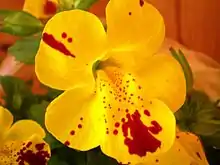Erythranthe lutea
Erythranthe lutea is a species of monkeyflower also known as yellow monkeyflower, monkey musk, blotched monkey flowers, and blood-drop-emlets.[2][3][4][5] It was formerly known as Mimulus luteus.[1][6][7][8]
| Erythranthe lutea | |
|---|---|
 | |
| Scientific classification | |
| Kingdom: | Plantae |
| Clade: | Tracheophytes |
| Clade: | Angiosperms |
| Clade: | Eudicots |
| Clade: | Asterids |
| Order: | Lamiales |
| Family: | Phrymaceae |
| Genus: | Erythranthe |
| Species: | E. lutea |
| Binomial name | |
| Erythranthe lutea | |
| Synonyms[1] | |
and others | |
Description
E. lutea blooms in the summer and grows to about 30 centimetres (12 in) in height.[9] The flowers are yellow with irregular reg blotches and the leaves are hairy, paired, and round.[4] Because of its yellow petals, E. luteus is in the "yellow monkeyflower" group, unlike most members of the genus, which have red or pink petals.[10]
Some sources list Erythranthe lutea separately due to chromosomal variations.[11][12] Barker, etal (2012) proposes a new taxonomy for Phrymaceae, leaving only 7 species in Mimulus, none in Mimulus lutea, and placing 111 in Erythranthe. Barker also offers 4 different options for how to implement this new taxonomy.[1]
The luteus group consists of Erythranthe luteus var. variegatus, E. naiandinus and E. cupreus.[10]
Distribution and habitat
Erythranthe lutea prefers to grow in wet habitats such as marshes and riverbanks. It grows in North and South America and has been naturalized in Britain,[5] having been first cultivated there circa 1826.[13]
References
- Barker, W. L. (Bill); et al. (2012). "A Taxonomic Conspectus of Phyrmaceae: A Narrowed Circumscription for MIMULUS, New and Resurrected Genera, and New Names and Combinations" (PDF). Phytoneuron. 39: 1–60. ISSN 2153-733X.
- GRIN (April 22, 2014). "Mimulus luteus L." Taxonomy for Plants. National Germplasm Resources Laboratory, Beltsville, Maryland: USDA, ARS, National Genetic Resources Program. Retrieved February 1, 2017.
- "Blood-drop-emlets (Mimulus luteus)". iNaturalist. Retrieved February 1, 2017.
- "Blotched Monkey Flower". Virtual Hebrides. Retrieved February 1, 2017.
- "Mimulus luteus L." Plants for a Future. Retrieved February 1, 2017.
- Beardsley, P. M.; Yen, Alan; Olmstead, R. G. (2003). "AFLP Phylogeny of Mimulus Section Erythranthe and the Evolution of Hummingbird Pollination". Evolution. 57 (6): 1397–1410. doi:10.1554/02-086. JSTOR 3448862. PMID 12894947. S2CID 198154155.
- Beardsley, P. M.; Olmstead, R. G. (2002). "Redefining Phrymaceae: the placement of Mimulus, tribe Mimuleae, and Phryma". American Journal of Botany. 89 (7): 1093–1102. doi:10.3732/ajb.89.7.1093. JSTOR 4122195. PMID 21665709.
- Beardsley, P. M.; Schoenig, Steve E.; Whittall, Justen B.; Olmstead, Richard G. (2004). "Patterns of Evolution in Western North American Mimulus (Phrymaceae)". American Journal of Botany. 91 (3): 474–4890. doi:10.3732/ajb.91.3.474. JSTOR 4123743. PMID 21653403.
- "Mimulus luteus". Water Garden Plants UK. Retrieved February 1, 2017.
- Cooley, Arielle M.; Willis, John H. (2009). "Genetic divergence causes parallel evolution of flower color in Chilean Mimulus". New Phytologist. 183 (3): 729–739. doi:10.1111/j.1469-8137.2009.02858.x. PMID 19453433.
- GRIN (April 22, 2014). "Erythranthe lutea (L.) G. L. Nesom". Taxonomy for Plants. National Germplasm Resources Laboratory, Beltsville, Maryland: USDA, ARS, National Genetic Resources Program. Retrieved February 1, 2017.
- Cooley, Arielle Marie (2008). Evolution of Floral Color Patterning in Chilean Mimulus. Durham. NC: Duke University. p. 37. ISBN 978-0549898689.
- Mimulus luteus (Blood-drop-emlets). Online Atlas of the British & Irish Flora. 1998. Retrieved February 2, 2017.
Further reading
- Edwards, S.T.; Lindley, J. (1826), The Botanical Register: Consisting of Coloured Figures of Exotic Plants Cultivated in British Gardens with Their History and Mode of Treatment plate 1030: Mimulus luteus; var. rivularis Crimsoned Mimulus; the Lowland variety